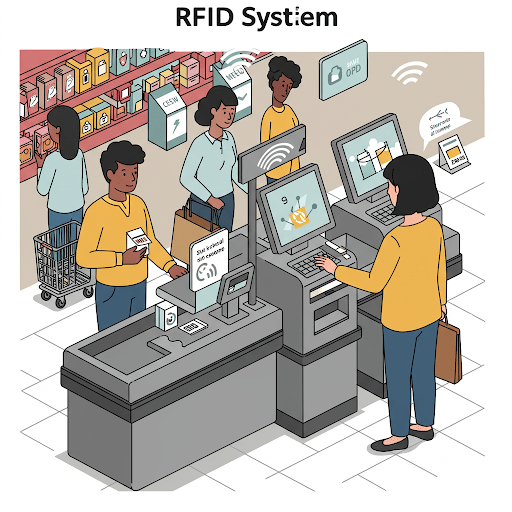In today’s fast-moving world, technology is getting smarter every day. Two powerful technologies that are creating a strong impact together are RFID (Radio Frequency Identification) and Edge Computing. When these two are combined, they bring faster, more effective , and real-time solutions to many industries like logistics, retail, manufacturing, and more.
What is RFID ?
RFID stands for Radio Frequency Identification. It is a wireless technology that uses radio waves to read and capture information stored on tags attached to objects.
These RFID tags can be fixed to items like products, books, packages, ID cards, etc. RFID readers detect these tags and collect data from them — all without any physical contact.
There are mainly 3 parts in an RFID system :
- RFID tags (attached to objects)
- RFID readers (to scan the tags)
- Backend software (to manage and analyse the data)
- RFID is used for tracking, inventory control, security, attendance, asset management, and more.
What is Edge Computing ?
Edge computing is a new way of processing data.
Instead of sending all the data to a central server (like in cloud computing), edge computing processes data locally, near the place where it is generated — that is, at the "edge" of the network.
In simple words:
“Edge computing means doing the data processing work close to the source (like an RFID reader), rather than sending everything to a faraway server.”
This saves time, internet bandwidth, and gives fast results.
Why Combine Edge Computing with RFID?
Normally, RFID readers send huge amounts of data to a central server or cloud for processing. But this creates some problems:
- Slower response time
- High internet/data usage
- Delays in decision-making
- Security risks due to data transmission
Now imagine if the RFID reader itself (or a nearby small device) could analyze the data on the spot, without needing to send it far — that’s what edge computing helps us do.
How Edge Computing Improves RFID Systems :
Benefit | Explanation | Real-World Example / Use Case |
Real-Time Decision Making | Edge computing allows RFID readers or local devices to process data on the spot. This enables immediate actions without waiting for cloud/server confirmation. | In a warehouse, if a high-value product is moved without authorization, an alarm triggers instantly. |
Reduced Network Load | Instead of sending all raw RFID data to the cloud, edge devices filter and send only meaningful information. This saves bandwidth and improves system efficiency. | In retail stores scanning thousands of items daily, only necessary stock changes are sent to the server. |
Better Data Security | Sensitive data stays within the local network or on-site, reducing the risk of interception, hacking, or data leaks over the internet. | In hospitals, patient tracking and medication records stay secure within the premises. |
Offline Functionality | Edge-enabled RFID systems continue working even without internet. Data is stored locally and synced later when the network is back online. | In remote farms or construction sites, RFID tracking continues uninterrupted during network outages. |
Smarter Alerts & Automation | Edge devices can trigger local alarms, activate devices, or send real-time mobile notifications based on RFID events — without waiting for cloud processing. | In smart factories or retail stores, systems automatically stop a conveyor or notify staff if a tag is missing or unauthorized. |
Real-Life Applications of RFID with Edge Computing
Retail Stores
RFID + Edge can monitor which products are moving fast or if any item is being taken without billing. Store managers get alerts immediately.
Hospitals
Patient records, medicine stock, and equipment tracking using RFID becomes faster and safer with local edge processing.
Logistics & Warehouses
Edge devices on trucks or loading bays can track goods in real-time and send updates only when required. This avoids unnecessary data load.
Libraries & Campuses
Smart RFID readers with edge features can instantly detect unauthorised book removals or entry of restricted persons even when the server is down.
Before Vs After edge Computing :
|
Future Possibilities :
As RFID hardware becomes smarter and cheaper, edge computing will become a default part of RFID solutions , especially in India where reliable internet is still a challenge in many areas.
We can expect to see :
- Smarter RFID gates in public spaces
- Intelligent vending machines using edge-powered RFID
- Real-time theft prevention systems in retail
- Fully automated, low-cost inventory systems for small businesses
RFID and Edge Computing together form a powerful combo. This combination is not just for large companies. Even small shops, libraries, schools, and warehouses can benefit from these technologies.

